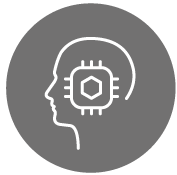
Artificial intelligence for social good 
The era of big data has drastically changed the way of economic behavior and business models, which also brings new challenges in economic research investigating these new features amongst essential questions for individuals, firms, and policymakers. The increasing availability of massive and complex data and high-performance computing capacity has provided opportunities for data scientists to improve existing data analytical models (or ‘machines’) and develop new tools to understand the mechanism of data generating processes (discovering the causal relationship from the data). An aim of this theme is to study important economic and financial problems utilizing newly developed machine learning methods.
Another aim of the theme is to investigate the dynamics of social changes under the influences of various hypothetical social settings and parameters. The main approach is to perform empirical studies using agent-based simulations. Different hypotheses can be abstracted by computational models, and implemented by computer programs. Observations of experimental results from agent-based simulations can then be analysed for the induction of conclusions (e.g., the causes, consequences and dynamics of the emergence of social norms). We also aim at building mathematical models of social dynamics. This enables further mathematical processing leading to results not readily available from experimental studies.
Project:
Treatment effect and instrumental variable models under high-dimensionality: estimation, inference and model selection (GRF-14617121, 2022-2024, PI: Prof. FAN Qingliang)
In modern policy evaluations, the increasing availability of rich datasets (such as massive administrative data and large survey data) with many individual features (variables) makes the estimation and inference on the heterogeneous or even personalized treatment effect an urgent task for theoretical econometricians and empirical economists. The accurate estimation of heterogeneous treatment effect is important for efficient policy making and social welfare evaluations. The economic policy, e.g., government bailout of small business or individuals during the hardship of COVID-19, would affect people with different economic variables such as debt levels, education, etc., differently. Estimation and inference on the potentially heterogeneous treatment effect is therefore important for modern program evaluations.
This project aims to develop econometric methods to deal with the common issues of causal inference in the form of treatment effect, such as heterogeneity, endogeneity, censored response variable, etc., amid large dimension of control variables and potential instruments. On one hand, more data provides the researchers more information on the subject of their study. On the other hand, it makes the conventional econometric methods infeasible to handle the high-dimensionality nature of the model. Specifically, this research project aims to study the average causal effect using double robustness method that relies on new machine learning methods. We consider the conditional average treatment effect and quantile treatment effect among censored response variables in a high-dimensional model. To address the endogeneity problem we consider a large number of instrumental variables and rely on the variable selection to get the optimal instruments. We also empirically investigate the effect of the firm culture on corporate behavior.
The novelty of our proposed method is that we first investigate the heterogeneous treatment effect with high-dimensional data and complex data structure such as censored response. We innovatively use the dimension reduction technique, taking into account the censored nature of the responses. Then a double robust method is applied to the nonparametric estimation of the heterogeneous treatment effect. Moreover, we consider the both irrelevant and invalid instruments in high-dimensional models.
The results of our study will be of practical use to policy makers, empirical economics researchers and biomedical researchers, etc., providing solutions to the complex data structure when evaluating the heterogeneous treatment effects. We advance the academic literature at the intersection of high-dimensional models, heterogeneous treatment effect, double robust estimation, instrumental variable method, by providing insights on how to make valid inference on the true parameter/functional of interests.
Project:
Formal Modelling of the Dynamics of Multi-agent Reinforcement
Learning: a Mean Field Theoretic Approach
(GRF 14206820, 2021-2023, PI: Prof LEUNG Ho Fung)
Research into learning through repeated agent interactions in multi-agent systems has become an active topic in the field of multiagent systems. It finds applications in a wide variety of domains. We note that a thorough understanding of multi-agent reinforcement learning is a current topic of research. There has been no research work reported on the formal modelling of the dynamics of multi-agent reinforcement learning for the general
n-agent settings, in particular, when n is very large. However, this is an important research topic. It enables researchers to give a detailed explanation of the process and find out the implications of the process. Generally, there is also a potential that the models can be further developed mathematically. Last but not least, a mathematical model might highlight the importance of certain parameters that would otherwise be overlooked in experimental studies. In this project, we propose to research into the dynamics of such systems with a mean field theoretic approach. We have obtained some very good initial results, which is presented in one of the most prestigious conference in Artificial Intelligence.
There are two specific objectives to be achieved in the project. First, we shall develop a general model of dynamics of multi-agent reinforcement learning in which there are many, many agents. Specifically, a general model will be able to handle the situations that the game of interaction is any game that allow agents to have one-to-one interactions. The model will also be able to allow agents to learn to cooperate with the opponents. The other objective is to build a formal model that incorporates the effects of additional external factors in the process of dynamics of multi-agent reinforcement learning. Examples of such factors are social values, influencer agents, inequity-aversity, and gist traces, to name a few. We hope that the effects of these factors, both on the learning dynamics and on the final outcome, can be analysed theoretically. They will also be verified experimentally if possible.
Theme Co-leaders:


